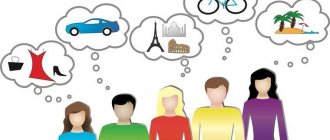Yuri Arshavsky, Doctor of Biological Sciences, University of California (San Diego, USA)
"Nature" No. 9, 2020
In blessed memory of the wonderful scientist and person V.P. Efroimson
Vladimir Pavlovich Efroimson (1908–1989)
People have always been interested in human nature. Among other things, a special place is occupied by the question of the origin of representatives of the biological species Homo sapiens
two opposite principles - altruistic and egoistic. The terms “altruism” and “egoism” are very multifaceted. In this case, I propose to conditionally interpret them as a tendency to manifest good and evil inherent in the human genome. Most people tend to do good deeds, i.e. to one degree or another provide selfless assistance to their fellow humans. By this I mean not only financial assistance, but also the willingness to risk one’s health and even life to save another, sometimes a stranger, especially when it comes to a child. At the same time, people are characterized by excessive selfishness, which manifests itself in aggressiveness, excessive greed, lust for power and often pushes them to extremely cruel acts.
Just as people differ in character and in the degree of talent (ability for languages, music, mathematics, etc.), they also differ in the expression of altruistic and egoistic principles. People with a pronounced tendency towards altruism are popularly called saints or righteous people; some of them went down in the history of human civilization forever. On the contrary, people endowed with boundless egoism often become criminals and murderers. If this kind of person is vested with absolute power, the number of his victims can be measured in many thousands and even millions. History knows many examples of the atrocities of tyrants from antiquity to the present day.
The study of identical and fraternal twins has shown that a person’s abilities and his characterological characteristics are largely determined by his genome and to a much lesser extent by upbringing and education [1–3]. Speaking about the role of genetic and environmental factors in determining human behavior, I must make one reservation. External factors that an organism normally encounters in the early stages of development can have a radical impact on all subsequent behavior of the organism, since they are necessary for the activation of the corresponding genes. Two examples to illustrate what has been said. Experiments on rats have shown that maternal affection (washing, licking, etc.) during a certain critical period (the first week after birth) is necessary for the formation of normal behavior in stressful situations. The effect of maternal affection is due to the activation of genes involved in the formation of neurohumoral mechanisms involved in reactions to stressful stimuli []. Another example is the existence of a critical period for language acquisition. Children who were isolated from the language environment until the age of 9–10 (the so-called “wolf children” or deaf children born of normal parents) lose the ability to learn language - regular or sign language. It can be assumed that the language environment plays a dual role. It not only allows the child to learn words and phrases of his native language, but also leads to the activation of genes that determine a person’s ability to communicate linguistically []. However, environmental effects associated with the activation of genetic programs are not the effects that are meant when talking about the role of genetic and environmental factors in determining human behavior.
How to explain the fact that in a person (both the biological species as a whole and in each individual) such opposite principles as altruism and selfishness coexist? There are two main answers to this question. According to religious views, the source of altruism is the divine origin of man. Difficulties arise with egoism, to explain which the existence of not only God, but also the devil is assumed. Science, on the contrary, easily explains human selfishness by its origin from animals, for which selfishness is the most important factor contributing to survival in the struggle for existence. It is much more difficult to find an explanation for the biological sources of altruism. The outstanding Russian geneticist V.P. Efroimson, in his book “Genetics of Ethics and Aesthetics,” proposed a paradoxical hypothesis: altruism is an adaptive factor that played an important role in the process of human evolution. Efroimson wrote that kindness and a chivalrous attitude towards women, the elderly, and children are those properties that inevitably developed under the influence of a special form of natural selection (group natural selection) as the ancestral man evolved into modern man. Meanwhile, another prominent biologist L.M. Chailakhyan argued the opposite: only one element of human society does not follow from natural selection - these are the moral principles of human behavior. (I note that despite all the scientific differences between these authors, they are united by a clearly expressed humanistic approach to the problem under consideration.) I think that the recently published results of paleoanthropological research not only support, but also deepen Efroimson’s point of view. Before moving on to describe these results, let me recall the main arguments he gives to substantiate the hypothesis about the adaptive role of altruism***.
Altruism concept
Altruism is human behavior that involves selflessly helping others, sometimes to the detriment of one’s own interests. A synonym for this word is “dedication.” An altruist refuses possible benefits and benefits in favor of another person or society as a whole. At the same time, he does not expect gratitude or reward from the person to whom he helped.
It is necessary to distinguish true altruism from imaginary. For example, a woman lives with her alcoholic husband, takes care of him and hopes that he will improve. At the same time, she completely forgets about herself, turning a blind eye to the fact that her husband is taking the last money out of the house. It would seem that such a woman’s behavior can be called altruistic. However, in fact, there are reasons why she tolerates her husband's antics. Perhaps the woman is afraid of being lonely and unwanted, and is afraid of difficulties when parting with her husband. Accordingly, there is still a benefit in her behavior.
True altruism involves heroic deeds in war, helping a drowning person provided by a person who himself can barely swim, the actions of firefighters pulling children out of fire. In these cases, it is completely impossible to trace any benefit in people’s behavior.
Examples
Subbotniks, protecting nature and cleaning the environment from garbage are an example of altruism
People do not always understand what exactly altruists do. Therefore, I bring to your attention examples of altruism.
- A soldier who lay down on a mine with his chest in order to save other colleagues during the war.
- Caring for a close relative, when an individual spends a lot of his time, attention and money.
- A mother caring for a sick, disabled child who does not think about herself at all. She allocates all funds for treatment and introduces the baby to specialists and teachers. Forgets about his personal life.
- Volunteers who care for sick animals or people in difficult situations
Other examples of altruism include:
- donation;
- subbotniks;
- charitable assistance to sick children or orphans;
- assistance from an experienced mentor to a beginner.
Now you know the meaning of altruism. As you can see, in most cases this state has a positive effect on the altruist and on his environment. However, it is worth considering possible disadvantages, in particular, the fact that for the sake of another person an individual can forget about himself and commit an act that will harm him. You need to be able to empathize and help those in need. Then our world will become a better place, and there will be more happy people.
Reasons for altruistic behavior
There are several theories that explain human altruistic behavior. First of all, these include the social responsibility of people and their need to give. According to this, a person strives to help his neighbor if he sees that he needs him and depends on his actions.
Altruistic behavior can be explained by a reluctance to observe the suffering of others. Moreover, if they stop, the negative emotions of the person who provided help disappear, or they are replaced by positive ones. From the point of view of this theory, altruism and egoism are closely intertwined.
Another reason for selflessness may be a person’s feeling of guilt. By performing a noble deed, he strives to atone for his sins.
Arguments for selfishness
Yes, at first glance it may seem that selfishness “fits” better into evolutionary theory. After all, if an individual thinks exclusively about itself, its chances of survival increase sharply. An egoist will get food for himself at any cost (for example, by snatching it from the mouth of a weaker relative), and then eat his prey alone. He will remain alive, which means he will pass on his genes to the next generation.
But for an altruist, nothing good seems to shine in this world. He will give his “piece of bread” to his neighbor and thereby reduce his chance of survival. He will spend his resources on his fellow tribesmen, sacrifice himself for the sake of others, and his altruistic lineage will end there.
Proponents of the philosophy of selfishness like to cite biologist and science popularizer Richard Dawkins.
In his controversial book The Selfish Gene, he argues that all living organisms exist for one single purpose: to promote the survival of genes. And we, according to the scientist, are just machines designed to transport, protect and distribute them.
The main quality of a gene that is going to survive and reproduce can only be ruthless selfishness. He cannot behave differently: if he gives even the slightest slack, he simply ceases to exist. And such genetic egoism becomes the basis for the behavior of each individual.
- But there are many examples of altruistic behavior in animals! - someone will probably object. - How does Dawkins explain them?
It's very simple: animal altruism is also initiated by selfish genes. And the point here is not at all about morality, and not about caring for one’s neighbor. Genes simply help their exact copies that are in other bodies. And altruistic individuals are just pawns that the gene sacrifices for the sake of its preservation.
What conclusions can be drawn from all this?
Dawkins himself insists that we are not obliged to obey our genes. People are influenced not only by hereditary predisposition, but also by culture. This means that we ourselves can choose whether to become selfish or not. And what would be the feat of altruism if it were genetically embedded in us?
Dawkins urges readers: “Let us try to teach generosity and altruism, for we are born selfish.”
Unfortunately, adherents of “natural egoism” are unlikely to pay attention to these words of the scientist. They snatch from his work only individual ideas and inflate them into revelations of a universal scale. In the book itself, everything is by no means so clear-cut, and it is not at all a justification of human selfishness, as they sometimes try to present it.
Moral altruism
Moral altruism is helping other people, which is based on a person’s conscience and moral principles. In this case, the individual acts based on his internal beliefs and concepts about how to act correctly in a given situation. Living according to conscience, a person becomes honest with himself and does not experience feelings of guilt or mental anguish.
One form of moral altruism is normative. It is expressed in a person’s struggle for justice, the desire to punish the guilty and defend the truth. For example, a judge gives a harsh sentence to a criminal, despite the very large sum offered to him as a bribe.
How to raise an altruistic child
In any situation, children follow the example of their parents, so if you dream of your child becoming an altruist when he grows up, you should set the right example for him. Every action of the parents will be assessed by the child in such a way that it needs to be repeated. Therefore, you should show your child that you help people. Teach that you need to do good and not refuse help if you are asked for it. Observing altruistic parents in front of them, children will definitely want to be the same.
It is important to show your child your own example.
Rational altruism
Rational altruism is a person’s attempt to find the right balance between his interests and the needs and needs of others. It presupposes a person’s meaningful performance of selfless actions and their preliminary consideration.
The rational theory of altruism allows an individual to protect himself from those who would take advantage of his honesty and kindness. That is why it is based on reciprocity of efforts. Without this, the relationship can become exploitative. A person needs to understand where and when to offer his help, and try not to act to the detriment of himself and his interests.
How do people feel about altruism?
Often people cannot understand altruists. Since the egoistic personality type is more common in modern society, often sincere and benevolent people who are ready to make sacrifices for the benefit of others look like black sheep. That is why egoists allow themselves to take advantage of the kindness of a few altruists, talk about their troubles and ask for help that they cannot tell. You can often observe how egoists achieve great success at work at the expense of those altruists who fulfill their duties for them. That is why important posts and positions are mainly given to cunning egoists.
Altruists are victims of modern society
Altruism from sympathy and empathy
Altruistic actions are very often performed by a person who is driven by certain experiences and feelings. It could be mercy, compassion or empathy. As a rule, the goodwill and dedication of altruists extends only to close people - relatives, friends, loved ones. If altruism goes beyond such relationships, it is called “philanthropy.” Most often it manifests itself in charity and helping those in need.
Selfishness concept
The concept opposite to altruism is egoism. It represents the behavior of an individual aimed solely at satisfying his interests and needs, obtaining benefits and benefits for himself. The consequences that such actions can lead to for other people are not taken into account by the egoist.
There is an opinion that every person is genetically predisposed to selfishness. This is explained by the long struggle for survival and natural selection in conditions in which people had to exist for a long time. Some scientists believe that all human actions are driven by selfishness. Even the best intentions and selfless actions actually have a hidden purpose to satisfy the needs of the person himself, and not those of others.
There are rational and irrational egoism. In the first case, a person evaluates and weighs the consequences of his actions. As a result, he acts as he thinks is right and appropriate. Irrational egoism involves rash and impulsive actions that can lead to unpleasant consequences for others.
Altruism and egoism
It would seem that such opposite concepts cannot be combined in one person and have nothing in common. Traditionally, we are accustomed to considering selfishness as a negative personality trait. People who possess it cause condemnation and censure from society. Altruism, on the contrary, implies a positive assessment. People have always revered selflessness and heroic deeds.
In fact, one cannot separate such concepts as altruism and egoism. 4th grade at school is the time to learn about the meaning of these words and the fact that they are perfectly combined in one person and complement each other. Both altruism and rational egoism are based on morality and morality. The value of human life is immeasurably great, both that of others and your own. Therefore, if an individual strives for personal gain and the fulfillment of his needs, this cannot be considered evil, of course, provided that other people do not suffer from this.
We must also remember that a person can change depending on what life lesson he receives. Selfishness and altruism can alternate in people. For example, if a person who has committed a noble deed receives condemnation instead of gratitude, or if his physical and moral capabilities to perform good deeds have dried up, then he can turn into an egoist. Caring for one's own person can also be replaced by altruism if suitable conditions are created for this.
The problem in modern society is the condemnation of both selfless behavior and selfishness. In the first case, people are often considered abnormal or do not believe them and look for hidden benefits in their actions. Selfishness is associated with greed and a disregard for others.
Types of interactions: egoistic and altruistic
People engage in two main types of interaction: selfish and altruistic. For example, competition or cooperation, conflict or agreement, opposition or concession, etc. Behind all these concepts the principle of interaction is clearly visible. The first group includes interactions that in one way or another “shatter” joint activity and represent a certain kind of obstacle to it. The second includes such manifestations of it that contribute to the organization of joint activities and are “positive” from this point of view.
Cooperation means the coordination of individual forces of participants (ordering, combining, summing up these forces). Cooperation is a necessary element of joint activity, generated by its special nature.
An important indicator of the quality of cooperative interaction is the inclusion of all participants in the process. Here it is important to analyze the contribution of each of the participants in the interaction and the degree of their involvement in it.
Selfishness and altruism
Content
Selfishness and altruism
The Roots of Altruism
Altruism and selfishness in their pure form: what are they?
Egoistic altruism and altruistic egoism
Pure altruism
The main feature of any interaction is interdependence. From birth to death, interactions are the basis and essence of a person's life experience. People have families, friends, co-workers and love to spend time with them, even do things for them. They get pleasure from this, although the pleasure is selfish. Those. a person receives pleasure because the interaction partner enjoys it, and this is a reward for him. A person is accustomed to receiving rewards for everything, this is how he satisfies his egoism.
In the integral approach, egoism and altruism are the main driving forces of evolution, which determine the principles of organization and dynamics of development of all levels and subsystems of the universe, all its elements: from subatomic particles to metagalaxies, from the kingdom of minerals to human society and man himself.
The primary and most important is the altruistic force (or the desire to give), since it is in it that the creative principle, the “energy of creation,” lies. This force shapes the universe and gives it the qualities of systematicity, interdependence and mutual inclusion.
Egoism, unlike the commonly used meaning of this word, is by no means reduced to competition and the desire to acquire certain benefits to the detriment of others. Rather, it can be defined as the desire of each element of the universe to exist, to maintain its integrity and, therefore, to receive and absorb something from the environment. Using the terminology of A. Bergson, we can say that the energy of the “life impulse” is embodied in the egoistic force.
Both forces are inextricably linked: complex relationships are established between them, in which confrontation, struggle and interaction, interpenetration take place. In the “field of tension” that arises between the two poles, global evolution unfolds, which triggers and brings to the fore alternately integrating and disintegrative processes.
Does the law of balance between egoistic and altruistic programs work in human society? What forms and features does their interaction take on in the sociocultural space? And what results does this lead to?
We believe there is good reason to believe that throughout history, humanity has developed primarily under the influence of selfishness. Altruistic power, for all its significance, has never been presented in its “pure form.” It was mixed with egoism, and was often suppressed by it or submitted to and receded into the background. Still, altruism could not be completely supplanted.
Altruism is considered to be one of the main human virtues. The willingness to act for the sake of other people, without taking into account personal interests (or even sacrificing them), built on a gratuitous basis, has always been praised in society as one of the noblest manifestations.
But altruism in its pure form almost does not exist, and many of its manifestations have common roots with egoism - an antagonistic character trait, many attribute to the negative characteristics of a person. I’ll try to explain why this is so now.
The Roots of Altruism
The roots of altruistic motives go back to hoary history, to the times when our ancestors still lived in the forests. For apes, who were social animals, the key to survival was the preservation of the herd as a whole. Therefore, in the course of natural selection, the most competitive and viable groups turned out to be those whose representatives did not show excessive aggression towards their fellow tribesmen, but periodically provided support to each other.
Altruism in its modern form originated in the primitive era. Later, already during the time of our not so distant ancestors (like the Cro-Magnons), the importance of altruistic actions for their society became even greater. The spread of people has led to tougher intraspecific competition that arises between communities fighting for a place in the sun. In such conditions, a phenomenon called among scientists “parochial altruism” firmly reigned. Parochial altruism is a form of altruism that is selective in nature and manifests itself only in relation to a narrow circle of close people.
The cause of wars in the primitive era was often precisely parochial altruism - the desire to provide living space for one’s own by displacing strangers. Let's imagine a situation: a person sees a fire in a neighboring house and selflessly rushes to save people from a burning apartment, without thinking about the consequences for himself. Is this an altruistic act? Of course, yes, and this act deserves to be awarded the medal “For saving the dead.” Now let’s look at the bigger picture and imagine that these actions to save a family of friends or relatives also resulted in the death of a dozen complete strangers, about whom the rescuer did not care. This is an example of parochial altruism: we sacrifice others, thinking only about our own.
It is from parochial altruism that the roots of altruism come in the sense that we are accustomed to seeing it. However, egoism also comes from the same area. Moreover, in most cases, both of these phenomena in an absolutely pure form do not exist in reality due to the complex structure of human consciousness and its psychology.
Altruism and selfishness in their pure form: what are they?
It is very easy to describe altruism and selfishness in their pure form. Pure altruism is a person’s actions for the benefit of another, performed by him selflessly, without taking into account personal interests or even contrary to them. Pure egoism, on the contrary, is a person’s actions aimed at extracting maximum benefit for himself, while completely ignoring the interests of other people.
An example of pure altruism is the situation from the film “Seven Lives,” in which Will Smith’s character donates organs and then commits suicide in order to save the maximum number of people. It’s not all that simple (we’ll get to that later), but the general message, I think, is clear: die saving others.
The manifestation of pure selfishness is often illustrated by movie villains who are ready to destroy humanity and/or plunge the world into chaos in order to gain absolute power over it. It is difficult to give a specific example, although there are many of them.
However, extreme manifestations of altruism and selfishness are not characteristic of the average person. This is hampered by the instinct of self-preservation, which we inherited from our animal ancestors and, in the course of evolution, transforms into a more perfect sense of self-preservation, driven by conscious motives (and not just “firmware” recorded in the brain by genes, like in simpler living beings).
Manifestations of pure altruism in normal (and close to them) conditions are blocked by a sense of self-preservation. Sailors covering the embrasure with their chests to save fellow soldiers from fire is possible only in extreme situations, against the backdrop of great stress, including in war. If we project them graphically onto a normal scale, then the people who committed such acts will be at the edges of the graph, while the majority will be in the center.
Manifestations of absolute egoism are also blocked by the brain, which is not experiencing excessive stress, using self-preservation mechanisms. Of course, it is quite possible to buy a machine gun on the black market and use it to shoot a cash-in-transit van or attack a bank to get millions. But every person understands that after this his life will never be the same (if he is not killed at all during his defense or during detention). The same applies to simpler situations. In order to satisfy your own interests, you can not care about your surroundings, your loved ones, but in the end it may turn out that the benefit is not as valuable as the sacrifice made in the form of changes in life.
As a result, we get a picture in which absolute manifestations of altruism and egoism in their pure form are classified as marginal. That is, those that are not typical for the average person.
Ordinary actions, regularly performed by people in everyday life and assessed by others as selfish or altruistic, are not absolute in nature, but are of a mixed nature.
Egoistic altruism and altruistic egoism
The mixed nature of altruistic and egoistic actions means that in any of such actions one can find features characteristic of the opposite. That is, “good” can be done in the name of personal interests, and “evil” can be done for the sake of some goal, assessed by the actor as the general good. People, without noticing it themselves, regularly show altruism, guided by selfish motives, and vice versa.
To verify this, it is enough to analyze the emotional state of a person before, during and after performing some action. Many people (if not almost all), voluntarily providing selfless help to others, ultimately experience an improvement in their emotional background. For example, a person in a not very good mood sees that a seriously ill child needs help, and donates money for his treatment. At the moment of transferring the funds, he experiences elation.
By helping others, a person himself receives satisfaction. After performing an act of charity, the mood usually improves. A person, realizing that he has done a good deed, experiences a feeling of satisfaction, his self-esteem increases. In this case, the same brain structures and the same biological mechanisms are used as when receiving pleasure from a selfish act. The joy of a person who, out of altruistic motives, has donated money or provided other assistance has the same nature as the joy of someone who has found and appropriated a wallet with a tidy sum.
Very often (in most cases) we do good deeds guided by selfish motives. The aforementioned film "Seven Lives" is a good illustration of this. The main character ultimately sacrificed seven parts of his body to save other people. But he did this not because he suddenly decided, without any reason, that seven other people’s lives were more important than one of his. At the beginning of the film, Will Smith's character caused an accident in which seven people died. Because of this, he experiences mental anguish and comes to the conclusion that the only way to atone for his guilt can be to save seven other lives, at the cost of his own.
If you dig deeper, it becomes clear that the motivation for the hero of the film is not pure altruism. The chosen option of atonement simply seemed to him the only way to satisfy his suffering. Without doing this, he would not have been able to live in peace in any case.
Self-sacrifice turned out to be the most suitable way to leave the discomfort zone. But such motivation is precisely the key for actions of an egoistic nature: “I’m uncomfortable now, I’ll do this, and then I’ll feel better.”
Here, not a real case is specifically cited as an example, but a cinematic situation, in order to show that even an act of self-sacrifice can have egoistic roots. By providing all possible help to others throughout his life, the hero could have saved not 7, but 77 or 777 lives, but he chose a different path. Of course, such a scenario would be boring, so no one made a movie about it. And so we got an interesting film and a vivid example of the fact that altruistic self-sacrifice can have selfish roots.
If we talk about real-life situations that are not so remarkable, we see examples of egoistic altruism or altruistic egoism everywhere. Good deeds, the motivation and outcome of which is an increase in mood and self-esteem, have precisely selfish roots. By completing them, people do not receive material returns, but they gain psychological satisfaction. And sometimes it is even more important than material satisfaction.
Most manifestations of altruism have egoistic roots. When we volunteer, donate funds to people for treatment, lend money to others indefinitely, or simply help someone standing on the side of the road to fix their car, we not only think that we are simply giving away our resources without receiving anything in return. At the same time, almost everyone also experiences satisfaction from the fact that he, perhaps, is not so bad and is not the last person on this earth, which helps to improve his moral state.
There is nothing wrong with this, so reasonable selfishness is not something to be ashamed of or condemn. You don’t need to think that if you do good purely for the sake of pleasure, then you are bad. No, everything is fine, that's how it should be. These are the features of our brain and consciousness acquired in the course of evolution.
Pure altruism
When a person always thinks about another, fulfilling his desires, this is called altruism. It is built on the good of another, on one’s own good through the good of another. To do this, you need to rise above yourself - that is, how others treat me does not matter, and I still treat them equally well.
We cannot attribute altruism to the inanimate, plant, animal level, meaning the connection of molecules, the work of cells or, say, an anthill. Any representative of any of these levels does not have freedom of choice - it is all determined by genes, laws, instincts.
Where there is freedom of choice, where there is room to rise above oneself, there is altruism.
When we talk about absolute, selfless altruism, then this is about the property of bestowal. That is, loving the property of bestowal is altruism. Therefore, no feedback from him—another person—can prevent him from loving him.
Bibliography:
1. Andreeva G.M. Social psychology. Moscow: Aspect Press, 1999 2. Laitman M., Khachaturyan V. Integral approach to world history. URL: https://www.michaellaitman.com/ru/news/integralny-podhod-k-vsemirnoy-istorii/ 3. Relationships between people - the principle of interdependence. URL: https://www.med74.ru/psy/articles/ya_i_socium/vzaimootnosheniya_mezhdu_lyudmi.html 4. Selfishness and altruism: a very fine line and common roots. URL: https://hype.tech/@ns3230/egoizm-i-altruizm-ochen-tonkaya-gran-i-obshchie-korni-9m9ecqe7 5. Altruism or egoism: what wins in a person? URL: https://psychologdo.ru/altruizm-ili-egoizm-chto-pobezhdaet-v-cheloveke
░░░░░░░░░░░░░░░░░░░░░░░░░░░░░░░░░░░░░░░░░░░░░░░░░░░░░░░░░░░░░
This material is part of the Integral Psychology course we are developing at the Integral World Research Institute (IWRI). The material is published under scientific. edited by prof. E. Eliav. General editing: T. Asher. Material preparation: R. Kabat. Course secretary: V. Shaposhnikova. Literary editor: A. Alexandrova.
Your email
Pros and cons of altruism
The positive aspects of selflessness are obvious to every person. Altruism is, first of all, helping people. If you managed to save your neighbor or provide him with support at the right time, this certainly deserves praise and approval. By performing selfless acts, helping others, each person makes our world a little kinder and more humane.
Are there any downsides to altruism? Within reasonable limits they are absent. However, if a person completely forgets about himself and his interests, this can cause significant harm to himself. Very often those around them begin to take advantage of a person’s kindness and kindness, shift their responsibilities to him, constantly ask him to borrow money and do not give it back. They know that they will never be refused and will always be helped, even if it is not so necessary. As a result, the altruist may be left with nothing, without receiving any gratitude for his good deeds.
Characteristics of altruists
Kindness and generosity are characteristic signs of an altruist
Let's look at what basic character traits a person who can be called an altruist should have. I bring to your attention manifestations of altruism:
- kindness - the desire to benefit people;
- sacrifice - the ability to give one’s strength, money, emotions for the sake of others;
- selflessness - does not require anything in return;
- humanism - sincere love for others;
- nobility - a tendency to do good deeds;
- generosity - the desire to share with people what you have;
- responsibility - an altruist realizes why he behaves this way, takes into account what consequences his action may lead to, and takes responsibility for his actions.
To become an altruist you do not need to be rich or occupy a certain place in society. Sometimes it is enough to provide support, pay attention, and provide care to help a person.











